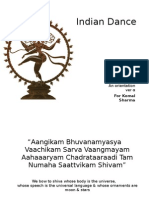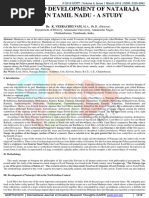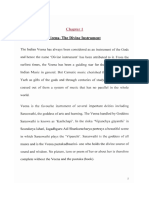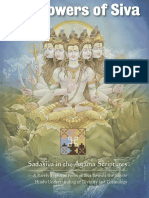0 ratings0% found this document useful (0 votes)
61 viewsNataraja
Nataraja
Uploaded by
Aspirant AspirantThe document describes a bronze sculpture of Nataraja, the Hindu god Shiva depicted as the cosmic dancer. Some key features of the sculpture are that Shiva holds a drum representing creation in one hand and eternal fire representing destruction in the other. He raises a third hand in a gesture of reassurance while a fourth hand points to his raised foot, indicating the path of salvation. The sculpture depicts important Hindu symbols like a snake representing dormant spiritual power.
Copyright:
© All Rights Reserved
Available Formats
Download as PDF, TXT or read online from Scribd
Nataraja
Nataraja
Uploaded by
Aspirant Aspirant0 ratings0% found this document useful (0 votes)
61 views2 pagesThe document describes a bronze sculpture of Nataraja, the Hindu god Shiva depicted as the cosmic dancer. Some key features of the sculpture are that Shiva holds a drum representing creation in one hand and eternal fire representing destruction in the other. He raises a third hand in a gesture of reassurance while a fourth hand points to his raised foot, indicating the path of salvation. The sculpture depicts important Hindu symbols like a snake representing dormant spiritual power.
Copyright
© © All Rights Reserved
Available Formats
PDF, TXT or read online from Scribd
Share this document
Did you find this document useful?
Is this content inappropriate?
The document describes a bronze sculpture of Nataraja, the Hindu god Shiva depicted as the cosmic dancer. Some key features of the sculpture are that Shiva holds a drum representing creation in one hand and eternal fire representing destruction in the other. He raises a third hand in a gesture of reassurance while a fourth hand points to his raised foot, indicating the path of salvation. The sculpture depicts important Hindu symbols like a snake representing dormant spiritual power.
Copyright:
© All Rights Reserved
Available Formats
Download as PDF, TXT or read online from Scribd
Download as pdf or txt
0 ratings0% found this document useful (0 votes)
61 views2 pagesNataraja
Nataraja
Uploaded by
Aspirant AspirantThe document describes a bronze sculpture of Nataraja, the Hindu god Shiva depicted as the cosmic dancer. Some key features of the sculpture are that Shiva holds a drum representing creation in one hand and eternal fire representing destruction in the other. He raises a third hand in a gesture of reassurance while a fourth hand points to his raised foot, indicating the path of salvation. The sculpture depicts important Hindu symbols like a snake representing dormant spiritual power.
Copyright:
© All Rights Reserved
Available Formats
Download as PDF, TXT or read online from Scribd
Download as pdf or txt
You are on page 1of 2
Nataraja (Bronze)
Technique : Lost-wax process
Nataraja (Lord of the Dance), the Hindu god Shiva in his form as the
cosmic dancer [Tandava], is represented in metal or stone in many Shaivite
temples, particularly in South India.
It is an important piece of Chola sculpture.
Some of the features of the Nataraja sculpture are:
o The upper right-hand holds the Drum, which signifies the sound of
creation.
o The upper left-hand holds the Eternal Fire, which represents
the destruction. Destruction is the precursor and inevitable counterpart
of creation.
o The lower right hand is raised in the gesture of Abhay
Mudra signifying benediction and reassuring the devotee to not be
afraid.
o The lower left-hand Points Towards The Upraised Foot and indicates
the path of salvation.
o Shiva is dancing on the figure of a small dwarf. The dwarf
symbolises ignorance and the ego of an individual.
o The matted and flowing locks of Shiva represent the flow of river
Ganges.
o In ornamentation, one ear of Shiva has a male earring while the other
has female. This represents the fusion of male and female and is often
referred to as Ardhanarishwar.
o A snake is twisted around the arm of Shiva. The snake symbolises
the kundalini power, which resides in the human spine in the dormant
stage. If aroused, one can attain true consciousness.
o The Nataraja is surrounded by a nimbus of glowing lights which
symbolises the vast unending cycles of time.
You might also like
- Chidambara RahasyaDocument11 pagesChidambara RahasyaRajesh NaiduNo ratings yet
- Chola BronzeDocument15 pagesChola BronzeWrishi BiswasNo ratings yet
- Depiction: (NƏT̪ Ə Ra DƷƏ) Tamil Malayalam Telugu Kannada Shiva BrahmaDocument4 pagesDepiction: (NƏT̪ Ə Ra DƷƏ) Tamil Malayalam Telugu Kannada Shiva BrahmanieotyagiNo ratings yet
- Nataraja, (Sanskrit:: Hindu God Shiva Shaiva ShivaDocument1 pageNataraja, (Sanskrit:: Hindu God Shiva Shaiva ShivasadhudasNo ratings yet
- NatarajaDocument5 pagesNatarajaBon Lester L. LampareroNo ratings yet
- Shiva As NatarajaDocument3 pagesShiva As NatarajaGray HoundyNo ratings yet
- Indi Templs - 17 (60-61)Document2 pagesIndi Templs - 17 (60-61)Guru VittalNo ratings yet
- The Dance of ShivaDocument13 pagesThe Dance of Shivatito154aNo ratings yet
- The Dance of ShivaDocument7 pagesThe Dance of Shivaazai nabihNo ratings yet
- The Dance of ShivaDocument7 pagesThe Dance of ShivaSri KalyanNo ratings yet
- Nataraja-The Dancing SivaDocument8 pagesNataraja-The Dancing SivaSivasonNo ratings yet
- Chola ArtDocument2 pagesChola ArtAvantika YadavNo ratings yet
- The Dance of ShivaDocument11 pagesThe Dance of Shivachitratr_bala7846100% (1)
- Siddhanta Deepika Volume 13Document599 pagesSiddhanta Deepika Volume 13BosRaj100% (1)
- Siddhanta Deepika Volume 13Document599 pagesSiddhanta Deepika Volume 13Sivason100% (1)
- The Sculpture of NatarajaDocument12 pagesThe Sculpture of NatarajaanupNo ratings yet
- Indian DanceDocument104 pagesIndian Dancebhisham67% (6)
- Notes Mam CorrectedDocument14 pagesNotes Mam CorrectedDeeptiNo ratings yet
- A Brief History of Nataraja, The Dancing Hindu God ShivaDocument37 pagesA Brief History of Nataraja, The Dancing Hindu God Shivapachak2010No ratings yet
- The Symbolic Dance of Shiva-NatarajaDocument3 pagesThe Symbolic Dance of Shiva-NatarajaSivason100% (1)
- Art and Culture Test 2 (3)Document20 pagesArt and Culture Test 2 (3)Chitra PatrikNo ratings yet
- Stories Behind The SculpturesDocument20 pagesStories Behind The SculpturesRahul GabdaNo ratings yet
- TVA BOK 0000648 SaivamDocument90 pagesTVA BOK 0000648 SaivamphantomkannanNo ratings yet
- 44 - Hindu Art and Architecture in IndiaDocument50 pages44 - Hindu Art and Architecture in IndiaPrachi LakheraNo ratings yet
- IJCRT1872373Document5 pagesIJCRT1872373Sadhish SharmaNo ratings yet
- Chapter 7Document10 pagesChapter 7kj197622No ratings yet
- 07 - Chapter 2 PDFDocument23 pages07 - Chapter 2 PDFKalimuthuNo ratings yet
- Shiva: Written byDocument8 pagesShiva: Written bySharanu HolalNo ratings yet
- An Example - and You Can Use This Too! Your Notes To Turn in Can Be in Bullet Format - We Will Turn Them Into An Essay Format in ClassDocument2 pagesAn Example - and You Can Use This Too! Your Notes To Turn in Can Be in Bullet Format - We Will Turn Them Into An Essay Format in ClassHugh BangNo ratings yet
- The Yogic Dance of MahesvaraDocument23 pagesThe Yogic Dance of MahesvaraJoo Barbosa100% (1)
- Sanjay More - Indian AstheticsDocument2 pagesSanjay More - Indian Astheticssathis_nskNo ratings yet
- NatarajarDocument3 pagesNatarajar11101955100% (1)
- Bollywood Largeprintv1Document210 pagesBollywood Largeprintv1Sachidananda KiniNo ratings yet
- Religion CrapDocument1 pageReligion CrapGabi SalvatoreNo ratings yet
- Pancha Bhoota StalamsDocument8 pagesPancha Bhoota StalamstekleyNo ratings yet
- Devatha Hastha NotesDocument4 pagesDevatha Hastha NotesUmaparvathy KaliappanNo ratings yet
- Indian Performing ArtsDocument21 pagesIndian Performing ArtsShashank Kumar SinghNo ratings yet
- Chidambara RahasyamDocument5 pagesChidambara Rahasyamvijiwrites2u0% (1)
- Mahisamardini Cult in Prachi ValleyDocument6 pagesMahisamardini Cult in Prachi Valleyamit kumar pradhanNo ratings yet
- 06 - Chapter 1 PDFDocument24 pages06 - Chapter 1 PDFYOGESWARI A/P SUBRAMANIAN STUDENTNo ratings yet
- 5 Forms of ShivaDocument20 pages5 Forms of ShivaJatin Yadav100% (1)
- Bharata NatyamDocument8 pagesBharata NatyamOscar RamirezNo ratings yet
- Wikipedia - ArdhanarishvaraDocument11 pagesWikipedia - Ardhanarishvarathewitness3No ratings yet
- SP-Vol.6 211Document5 pagesSP-Vol.6 211NITHISHKUMAR.SNo ratings yet
- Astronomical Association of NatarājaDocument11 pagesAstronomical Association of NatarājaUday DokrasNo ratings yet
- Lingam, Lord Shiva, Hindu MythologyDocument2 pagesLingam, Lord Shiva, Hindu MythologyDevendra PadalkarNo ratings yet
- Narayana Hari Part of TrimurtiDocument9 pagesNarayana Hari Part of Trimurtiapi-249153555No ratings yet
- 5 6185824582184730858Document9 pages5 6185824582184730858Rama BaiNo ratings yet
- Unit 5 Asian NotebookDocument33 pagesUnit 5 Asian Notebookguoino9108No ratings yet
- Bharata NatyamDocument9 pagesBharata NatyamkoyasrujanaNo ratings yet
- Indian Dance & MusicDocument85 pagesIndian Dance & MusicSunil Upadhyaya0% (1)
- Five Powers of Siva EiDocument10 pagesFive Powers of Siva EidbbircsNo ratings yet
- The Dance DivineDocument4 pagesThe Dance DivineSivasonNo ratings yet
- UPSC Civil Services Examination: UPSC Notes (GS-I) Topic: Indian Bronze Sculptures (Art and Culture Notes For UPSC)Document3 pagesUPSC Civil Services Examination: UPSC Notes (GS-I) Topic: Indian Bronze Sculptures (Art and Culture Notes For UPSC)SreeNo ratings yet
- Iconography in Kerala Tantric PDFDocument26 pagesIconography in Kerala Tantric PDFJpsworldNo ratings yet
- VeenaDocument6 pagesVeenaShakti Yadav100% (1)
- 4 Indus Dancing Girls Represent Mohini SDocument20 pages4 Indus Dancing Girls Represent Mohini Sjuan peresNo ratings yet
- Everyday Creativity: Singing Goddesses in the Himalayan FoothillsFrom EverandEveryday Creativity: Singing Goddesses in the Himalayan FoothillsNo ratings yet
- Definitions of Important Internal Security Terms & Concepts CompilationDocument2 pagesDefinitions of Important Internal Security Terms & Concepts CompilationAspirant AspirantNo ratings yet
- Bhakti SaintsDocument5 pagesBhakti SaintsAspirant AspirantNo ratings yet
- RSTV+AIR-Make in India - Make For WorldDocument5 pagesRSTV+AIR-Make in India - Make For WorldAspirant AspirantNo ratings yet
- Current Affairs (PDF) - May 1-15, 2022: Join Https://t.me/thehindu000Document137 pagesCurrent Affairs (PDF) - May 1-15, 2022: Join Https://t.me/thehindu000Aspirant AspirantNo ratings yet































































